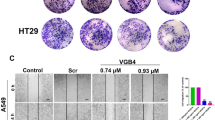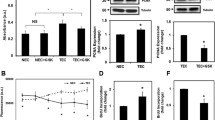Abstract
Tumor vascularization is a complex process that requires structural reorganization and increased motility by endothelial cells. Studies were conducted to identify the tumor-derived mediators and signaling pathways that lead to this increased endothelial cell motility. Using the Lewis lung carcinoma (LLC) tumor model, these studies showed that prostaglandin E2 (PGE2) and transforming growth factor-β (TGFβ) were the mediators that were responsible for the migration-stimulatory activity produced by the tumor cells. The response of endothelial cells to these tumor-derived motility-stimulatory factors involved a decline in the activity of the serine/threonine phosphatase PP-2A. Inhibition PP-2A either pharmacologically or genetically increased endothelial cell migration. Concurrent with the decline in PP-2A activity as a result of exposure to PGE2/TGFβ was a loss of PP-2A co-precipitation with the inositol phosphatase PTEN and an increase in the PTEN serine phosphorylation level. Since hyperphosphorylation has been shown to inhibit the ability of PTEN to act as an antagonist to phosphatidylinositide 3-kinase (PI3K), the role of PI3K in PGE2/TGFβ-stimulated migration was examined. These studies showed that the increased endothelial cell motility that resulted from PGE2/TGFβ inhibition of PP-2A was dependent on PI3K.
Similar content being viewed by others
References
Gupta RA, Tejada LV, Tong BJ et al. Cyclooxygenase-1 is overexpressed and promotes angiogenic growth factor production in ovarian cancer. Cancer Res 2003; 63: 906–11.
Stoeltzing O, Ahmad SA, Liu W et al. Angiopoietin-1 inhibits vascular permeability, angiogenesis, and growth of hepatic colon cancer tumors. Cancer Res 2003; 63: 3370–7.
Zhang L, Yang N, Park JW et al. Tumor-derived vascular endothelial growth factor up-regulates angiopoietin-2 in host endothelium and destabilizes host vasculature, supporting angiogenesis in ovarian cancer. Cancer Res 2003; 63: 3403–12.
Tsuda S, Ohtsuru A, Yamashita S et al. Role of c-Fyn in FGF-2-mediated tube-like structure formation by murine brain capillary endothelial cells. Biochem Biophys Res Commun 2002; 290: 1354–60.
Vinals F, Pouyssegur J. Transforming growth factor b1 (TGF-b1) promotes endothelial cell survival during in vitro angiogenesis via an autocrine mechanism implicating TGF-a signaling. Mol Cell Biol 2001; 21: 7218–30.
Rofstad EK, Halsor EF. Vascular endothelial growth factor, interleukin 8, platelet-derived endothelial cell growth factor, and basic fibroblast growth factor promote angiogenesis and metastasis in human melanoma xenografts. Cancer Res 2000; 60: 4932–8.
Roeckl W, Hecht D, Sztajer H et al. Differential binding characteristics and cellular inhibition by soluble VEGF receptors 1 and 2. Exp Cell Res 1998; 241: 161–70.
Benefield J, Petruzzelli GJ, Fowler S et al. Regulation of the steps of angiogenesis by human head and neck squamous cell carcinomas. Invasion Metast 1996; 16: 291–301.
Yu CF, Sanders MA, Basson MD. Human caco-2 motility redistributes FAK and paxillin and activates p38 MAPK in a matrix-dependent manner. Am J Physiol Gastrointest Liver Physiol 2000; 278: G952–66.
Vadlamudi R, Adam L, Talukder A et al. Serine phosphorylation of paxillin by heregulin-b1: Role of p38 mitogen activated protein kinase. Oncogene 1999; 18: 7253–64.
Young MRI, Kolesiak K, Meisinger J. Protein phosphatase-2A regulates endothelial cell motility and both the phosphorylation as well as stability of focal adhesion complexes. Int J Cancer 2002; 100: 276–82.
Romer LH, Burridge K, Turner CE. Signaling between the extracellular matrix and the cytoskeleton: Tyrosine phosphorylation and focal adhesion assembly. Cold Spring Harb Symp Quant Biol 1992; 57: 193–202.
Kain KH, Klemke RL. Inhibition of cell migration by Abl-family tyrosine kinases through uncoupling of Crk/CAS complexes. J Biol Chem 2001; 11: 16185–92.
Reiske HR, Kao SC, Cary LA et al. Requirement of phosphatidylinositol 3-kinase in focal adhesion kinase-promoted cell migration. J Biol Chem 1999; 274: 12361–6.
Ozes ON, Akca H, Mayo LD et al. A phosphatidylinositol 3-kinase/Akt/mTOR pathway mediates and PTEN antagonizes tumor necrosis factor inhibition of insulin signaling through insulin receptor substrate-1. Proc Natl Acad Sci USA 2001
Vazquez F, Ramaswamy S, Nakamura N et al. Phosphorylation of the PTEN tail regulates protein stability and function. Mol Cell Biol 2000; 20: 5010–8.
Shimao Y, Nabeshima K, Inoue T et al. TPA-enhanced motility and invasion in a highly metastatic variant (L-10) of human rectal adenocarcinoma cell line RCM-1: Selective role of PKCa and its inhibition by a combination of PDBu-induced PKC downregulation and antisense oligonucleotides treatment. Clin Exp Metast 1999; 17: 351–60.
Young MRI, Young ME, Lozano Y et al. Activation of protein kinase A increases the in vitro invasion, migration, and adherence to reconstituted basement membrane by Lewis lung carcinoma tumor cells. Invasion Metast 1992; 12: 253–63.
Montesano R, Pepper MS, Mohle-Steinlein U et al. Increased proteolytic activity is responsible for the aberrant morphogenetic behavior of endothelial cells expressing the middle T oncogene. Cell 1990; 62: 435–45.
Chung H, Brautigan DL. Protein phosphatase 2A suppresses MAP kinase signalling and ectopic protein expression. Cell Signal 1999; 11: 575–80.
Metz R, Vellody K, Patel S et al. Vitamin D3 and ceramide reduce the invasion of tumor cells through extracellular matrix components by elevating protein phosphatase-2A. Invasion Metast 1997; 16: 280–90.
Young MRI, Liu SW, Meisinger J. Differences in association of the serine/threonine protein phosphatase PP-2A with microtubules of metastatic and nonmetastatic tumor cells. Clin Exp Metast 2001; 18: 407–13.
Ades EW, Candal FJ, Swerlick RA et al. HMEC-1: Establishment of an immortalized human microvascular endothelial cell line. J Invest Dermatol 1992; 99: 683–90.
Hardie DG, Haystead AJ, Sim ATR. Use of okadaic acid to inhibit protein phosphatases in intact cells. Meth Enzymol 1991; 201: 469–76.
Funasaka T, Haga A, Raz A et al. Tumor autocrine motility factor is an angiogenic factor that stimulates endothelial cell motility. Biochem Biophys Res Commun 2001; 285: 118–28.
Benefield J, Meisinger J, Petruzzelli GJ et al. Endothelial cell response to human head and neck squamous cell carcinoma cells involves downregulation of protein phosphatases-1/2A, cytoskeletal depolymerization and increased motility. Invasion Metast 1997; 17: 210–20.
Witt CJ, Meisinger J, Werra G et al. Inter-relationship between protein phosphatase-2A and the cytoskeletal architecture during the endothelial cell response to soluble products produced by human head and neck cancer. Otolaryngol Head Neck Surg 2000; 122: 721–7.
Zhao M, Bai H, Wang E et al. Electrical stimulation directly induces pre-angiogenic responses in vascular endothelial cells by signaling through VEGF receptors. J Cell Sci 2004; 117: 397–405.
Huang J, Kontos CD. PTEN modulates vascular endothelial growth factor-mediated signaling and angiogenic effects. J Biol Chem 2002; 277: 10760–6.
Grosskreutz CL, Anand-Apte B, Dupl et al. Vascular endothelial growth factor-induced migration of vascular smooth muscle cells in vitro. Microvasc Res 1999; 58: 128–36.
Gruber BL, Marchese MJ, Kew R. Angiogenic factors stimulate mastcell migration. Blood 1995; 86: 2488–93.
Pullar CE, Chen J, Isseroff RR. PP2A activation by beta2-adrenergic receptor agonists: Novel regulatory mechanism of keratinocyte migration. J Biol Chem 2003; 278: 22555–62.
Urbich C, Reissner A, Chavakis E et al. Dephosphorylation of endothelial nitric oxide synthase contributes to the anti-angiogenic effects of endostatin. FASEB J 2002; 16: 706–8.
Tai YT, Podar K, Catley L et al. Insulin-like growth factor-1 induces adhesion and migration in human multiple myeloma cells via activation of beta1-integrin and phosphatidylinositol 3'-kinase/AKT signaling. Cancer Res 2003; 63: 5850–8.
Yang GY, Yao JS, Huey M et al. Participation of PI3K and ERK1/2 pathways are required for human brain vascular smooth muscle cell migration. Neurochem Int 2004; 44: 441–6.
Pore N, Liu S, Haas-Kogan DA et al. PTEN mutation and epidermal growth factor receptor activation regulate vascular endothelial growth factor (VEGF) mRNA expression in human glioblastoma cells by transactivating the proximal VEGF promoter. Cancer Res 2003; 63: 236–41.
Author information
Authors and Affiliations
Rights and permissions
About this article
Cite this article
Young, M.R.I. Tumor-derived prostaglandin E2 and transforming growth factor-β stimulate endothelial cell motility through inhibition of protein phosphatase-2A and involvement of PTEN and phosphatidy linositide 3-kinase. Angiogenesis 7, 123–131 (2004). https://doi.org/10.1007/s10456-004-1027-2
Issue Date:
DOI: https://doi.org/10.1007/s10456-004-1027-2




